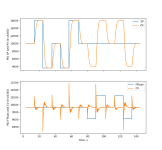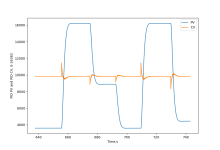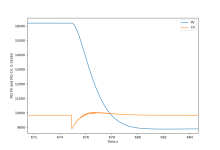A little more data, the SP and Feed Forward bias, in this plot.
The point is that, with a value of 0 for T
I (so no I-action), bias and SP have a functionally similar effect, with opposite sign and different scale of course. The beam always ends up level (modeled as CV = [P + I + D + FFbias] at 9829 = [60% × 16383]).
The bias steps' magnitudes are 780 and 1560, so with a K
C of 0.13 that offsets the PV (and Error) by 6000 and 12000 (≡ 780÷K
C and 1560÷K
C) to counter the bias and bring the beam back to level.
If GIT can modify the physical model to be closer to the ideal model, which is I think mostly about friction (use a slide rule

), then something like this should be achievable. It does teach a fair bit about how the PID works internally*. Also, even though T
I is not strictly needed, it could still be experimented with, which would teach about its inverse-time scaling and relationship with the bias.
* But not so much about tuning, because we don't tune PIDs, we tune systems.
I envision a series of modules:
- connecting a servo (4-20mA; + and -; scaling)
- connecting an IR sensor (same; PNP vs. NPN)
- characterizing the system
- PID in manual, adjust CV
- how ball behaves when beam is level, or
- when beam tilts
- determining a bias value for when error and error rate are both 0
- measure the system response
- this could be some challenging PLC code to a newbie
- P-only
- trying to drive error towards 0
- cycling - why?
- i.e. how the addition closed loop control changes how the system behaves
- effect of KC on the system
- effect of bias on the system: offset
- effect of SP change on the system: offset
- effect of scheduling: none; why?
- PD-only
- TIME!
- Why is PID scheduling so important?
- Why did scheduling not matter for P-only?
- Plug the system model response measurement results into a worksheet based on the TF
- solving a quadratic equation should not be too far out of reach,
- or it could be a canned approach on the sheet.
- Wow, that's good control, why did that happen?
- and who do I ask for the worksheet for the next process I have to control?
- wouldn't it be great if the system designers of the process provided such a worksheet based on a model, so that all I have to do is make some measurements, plug those into the worksheet, and get workable tuning parameters?
- changing SP does not cause offset this time. why not?
- changing bias does still cause offset. why?
- PID
- cycling again
- why? windup!
- back to the PID equation: similarities between bias, SP, and I-accumulation: dX/dt = when E=0 and dE/dt=0.
- bias no longer causes offset: both are "eaten" by I-action over time.
Because the proper way to do this is to teach Laplace Transforms, but practically that is beyond most who will ever touch a PID, as @Peter has to agree (because he is constantly saying it).
So the next best thing might be to at least give them an idea of what tuning a system with a PID, not just a PID, is about. Also practical things like how to ensure the PID is scheduled and configured properly, where the various knobs are, and where and how they
effect (

) a system response.








